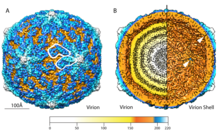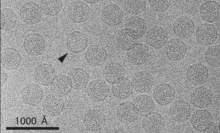Totiviridae
Totiviridae is a family of viruses. Giardia lamblia, leishmania, trichomonas vaginalis, and fungi serve as natural hosts. There are currently 28 species in this family, divided among 5 genera.[1][2]
| Totiviridae | |
|---|---|
 | |
| Capsid structure of Helminthosporium victoriae virus 190S (HvV190S) | |
 | |
| Cryo-EM of HvV190S virions. | |
| Virus classification | |
| (unranked): | Virus |
| Realm: | Riboviria |
| Kingdom: | Orthornavirae |
| Phylum: | Duplornaviricota |
| Class: | Chrymotiviricetes |
| Order: | Ghabrivirales |
| Family: | Totiviridae |
| Genera | |
Taxonomy
Group: dsRNA
- Family: Totiviridae
- Genus: Giardiavirus
- Giardia lamblia virus
- Genus: Leishmaniavirus
- Leishmania RNA virus 1
- Leishmania RNA virus 2
- Genus: Totivirus
- Saccharomyces cerevisiae virus L-A
- Saccharomyces cerevisiae virus L-BC (La)
- Scheffersomyces segobiensis virus L
- Tuber aestivum virus 1
- Ustilago maydis virus H1
- Xanthophyllomyces dendrorhous virus L1A
- Xanthophyllomyces dendrorhous virus L1B
- Genus: Trichomonasvirus
- Trichomonas vaginalis virus 1
- Trichomonas vaginalis virus 2
- Trichomonas vaginalis virus 3
- Trichomonas vaginalis virus 4
- Genus: Victorivirus
- Aspergillus foetidus slow virus 1
- Beauveria bassiana victorivirus 1
- Chalara elegans RNA Virus 1
- Coniothyrium minitans RNA virus
- Epichloe festucae virus 1
- Gremmeniella abietina RNA virus L1
- Helicobasidium mompa totivirus 1-17
- Helminthosporium victoriae virus 190S
- Magnaporthe oryzae virus 1
- Magnaporthe oryzae virus 2
- Rosellinia necatrix victorivirus 1
- Sphaeropsis sapinea RNA virus 1
- Sphaeropsis sapinea RNA virus 2
- Tolypocladium cylindrosporum virus 1
Structure
Viruses in Totiviridae are non-enveloped, double-stranded RNA viruses with icosahedral geometries, and T=2 symmetry. The virion consists of a single capsid protein and is about 40 nanometers in diameter.
The genome is composed of a linear double-stranded RNA molecule of 4.6–6.7 kilobases. It contains 2 overlapping open reading frames (ORF)[1]—gag and pol—which respectively encode the capsid protein and the RNA-dependent RNA polymerase. Some totiviruses contain a third small potential ORF.
| Genus | Structure | Symmetry | Capsid | Genomic arrangement | Genomic segmentation |
|---|---|---|---|---|---|
| Giardiavirus | Icosahedral | T=2 | Non-enveloped | Linear | Monopartite |
| Leishmaniavirus | Icosahedral | T=2 | Non-enveloped | Linear | Monopartite |
| Totivirus | Icosahedral | T=2 | Non-enveloped | Linear | Monopartite |
| Victorivirus | Icosahedral | T=2 | Non-enveloped | Linear | |
| Trichomonasvirus | Icosahedral | T=2 | Non-enveloped | Linear |
Life cycle
Viral replication is cytoplasmic. Replication follows the double-stranded RNA virus replication model. Double-stranded RNA virus transcription is the method of transcription. Translation takes place by -1 ribosomal frameshifting, +1 ribosomal frameshifting, viral initiation, and RNA termination-reinitiation. The virus exits the host cell by cell-to-cell movement. Giardia lamblia protozoa, leishmania protozoa, protozoan trichomonas vaginalis, and fungi serve as the natural host.[1]
| Genus | Host details | Tissue tropism | Entry details | Release details | Replication site | Assembly site | Transmission |
|---|---|---|---|---|---|---|---|
| Giardiavirus | Protozoa | None | Cell receptor endocytosis | Exocytosis | Cytoplasm | Cytoplasm | Passive diffusion |
| Leishmaniavirus | Protozoa: leishmania | None | Cell receptor endocytosis | Cell division | Cytoplasm | Cytoplasm | Cell division |
| Totivirus | Fungi: saccharomyces cerevisiae; fungi: smut fungi | None | Cytoplasmic exchange, sporogenesis; hyphal anastomosis | Cytoplasmic exchange, sporogenesis; hyphal anastomosis | Cytoplasm | Cytoplasm | Cell division; sporogenesis; cell fusion |
| Victorivirus | Fungi | None | Unknown | Unknown | Cytoplasm | Cytoplasm | Unknown |
| Trichomonasvirus | Protozoa | Endocytosis | Unknown | Unknown | Cytoplasm | Cytoplasm | Unknown |
Examples
An example of fungal totivirus is the L-A helper virus, a cytoplasmic virus found primarily in Saccharomyces cerevisiae.[3]
References
- "Viral Zone". ExPASy. Retrieved 15 June 2015.
- ICTV. "Virus Taxonomy: 2014 Release". Retrieved 15 June 2015.
- https://aem.asm.org/content/aem/early/2016/12/05/AEM.02991-16.full.pdf